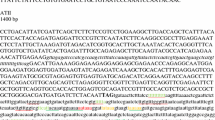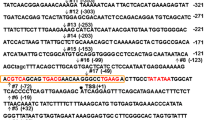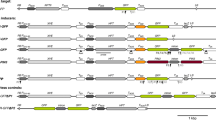Abstract
Homology in the promoter region leads to transcriptional gene silencing (TGS). This could be circumvented by designing synthetic promoters which are functionally similar but divergent in their sequence. In the present study, we asked whether such synthetic promoters can escape trans-inactivation when challenged with a silenced copy of the wild-type prototype. We tested the activity of two synthetic cauliflower mosaic virus 35S (35S) domain A promoters, 2mA and 3mA, with only 35% and 41% sequence identity with the wild type 35S (wtA) in the presence of silencing locus 271 of Nicotiana tabacum that inactivates any 35S promoter driven transgene through TGS. Based on comparison of β-glucuronidase (gus) activity under the transcriptional control of wtA, 2mA, and 3mA in the presence and absence of the silencing locus, we demonstrate that the inactivation of the 2mA and 3mA promoters is significantly delayed in comparison to that of wtA although microhomology at the transcription factor binding sites eventually leads to the silencing of these synthetic promoters. We further postulate that it is possible to design functional synthetic promoters that can escape gene silencing in the background of silencing locus if the cis-elements are smaller and do not contain methylation prone CG and CNG.





Similar content being viewed by others
References
Arumugam N, Gupta V, Jagannath A, Mukhopadhyay A, Pradhan AK, Burma PK, Pental D (2007) A passage through in vitro culture leads to efficient production of marker-free transgenic plants in Brassica juncea using the Cre-loxP system. Transgenic Res 16:703–712. doi:10.1007/s11248-006-9058-7
Benfey PN, Ren L, Chua N-H (1990) Tissue-specific expression from CaMV 35S enhancer subdomains in early stages of plant development. EMBO J 9:1677–1684
Bhattacharyya-Pakrasi M, Pen J, Elmer JS, Laco G, Shen P, Kaniewska MB, Kononowicz H, Wen F, Hodges TK, Beachy RN (1993) Specificity of a promoter from the rice tungro baciliform virus for expression in phloem tissues. Plant J 4:71–79. doi:10.1046/j.1365-313X.1993.04010071.x
Bhullar S, Chakravarthy S, Advani S, Datta S, Pental D, Burma PK (2003) Strategies for development of functionally equivalent promoters with minimum sequence homology for transgene expression in plants: cis-elements in a novel DNA context versus domain swapping. Plant Physiol 132:988–998. doi:10.1104/pp.103.020602
Bradford MM (1976) A rapid and sensitive method for the quantitation of microgram quantities of protein utilizing the principle of protein-dye binding. Anal Biochem 72:248–254. doi:10.1016/0003-2697(76)90527-3
Comai L, Moran P, Maslyar D (1990) Novel and useful properties of a chimeric plant promoter combining CaMV 35S and MAS elements. Plant Mol Biol 15:373–381. doi:10.1007/BF00019155
Depicker A, van Montagu M (1997) Post-transcriptional gene silencing in plants. Curr Opin Cell Biol 9:373–382. doi:10.1016/S0955-0674(97)80010-5
Dey N, Maiti IB (1999) Structure and promoter/leader deletion analysis of Mirabilis mosaic virus (MMV) full-length transcript promoter in transgenic plants. Plant Mol Biol 40:771–782. doi:10.1023/A:1006285426523
Diéguez MJ, Vaucheret H, Paszkowski J, Scheid OM (1998) Cytosine methylation at CG and CNG sites is not a prerequisite for the initiation of transcriptional gene silencing in plants, but it is required for its maintenance. Mol Gen Genet 259:207–215. doi:10.1007/s004380050806
Fagard M, Vaucheret H (2000) (Trans) gene silencing in plants: how many mechanisms? Annu Rev Plant Physiol Plant Mol Biol 51:167–194. doi:10.1146/annurev.arplant.51.1.167
Hajdukiewicz P, Svab Z, Maliga P (1994) The small, versatile pPZP family of Agrobacterium binary vectors for plant transformation. Plant Mol Biol 25:989–994. doi:10.1007/BF00014672
Holmberg N, Harker M, Gibbard CL, Wallace AD, Clayton JC, Rawlins S, Hellyer A, Safford R (2002) Sterol C-24 methyltransferase type 1 controls the flux of carbon into sterol biosynthesis in tobacco seed. Plant Physiol 130:303–311. doi:10.1104/pp.004226
Iyer ML, Kumpatla SP, Chandrasekharan BM, Hall TC (2000) Transgene silencing in monocots. Plant Mol Biol 43:323–346. doi:10.1023/A:1006412318311
Jefferson RA (1987) Assaying chimeric genes in plants: the GUS gene fusion system. Plant Mol Biol Rep 5:387–405. doi:10.1007/BF02667740
Kumpatla SP, Chandrasekharan MB, Lyer LM, Li G, Hall TC (1998) Genome intruder scanning and modulation systems and transgene silencing. Trends Plant Sci 3:97–104. doi:10.1016/S1360-1385(97)01194-1
Maiti IB, Gowda S, Kierman J, Ghosh SK, Shepherd RJ (1997) Promoter/leader analysis and plant expression vectors with the Figwort mosaic virus (FMV) full-length transcript (FLt) promoter containing single and double enhancer domains. Transgenic Res 6:143–156. doi:10.1023/A:1018477705019
Matzke AM, Aufsatz W, Kanno T, Mette FM, Matzke MJA (2002) Homology-dependent gene silencing and host defence in plants. Adv Genet 46:235–273. doi:10.1016/S0065-2660(02)46009-9
Matzke MA, Matzke AJM (1995) How and why do plants inactivate homologous (trans)genes? Plant Physiol 107:679–685. doi:10.1104/pp.107.3.679
Medberry SL, Lockhart BEL, Olszewski NE (1992) The Commelina yellow mottle virus promoter is a strong promoter in vascular and reproductive tissues. Plant Cell 4:185–192. doi:10.1105/tpc.4.2.185
Meyer P, Saedler H (1996) Homology-dependent gene silencing in plants. Annu Rev Plant Phys 47:23–48. doi:10.1146/annurev.arplant.47.1.23
Mourrain P, van Blokland R, Kooter JM, Vaucheret H (2007) A single transgene locus triggers both transcriptional and post-transcriptional silencing through double-stranded RNA production. Planta 225:365–379. doi:10.1007/s00425-006-0366-1
Ni M, Cui D, Einstein J, Narasimhulu S, Vergara CE, Gelvin SB (1995) Strength and tissue specificity of chimeric promoters derived from the octopine and mannopine synthase genes. Plant J 7:661–676. doi:10.1046/j.1365-313X.1995.7040661.x
Rogers SO, Bendich AJ (1994) Extraction of total cellular DNA from plants, algae and fungi. In: Gelvin SB, Schilperoort RA (eds) Plant molecular biology manual, D1, 2nd edn. Kluwer Academic, Dordrecht, pp 1–8
Rushton PJ, Reinstadler A, Lipka V, Lippok B, Somssich IE (2002) Synthetic plant promoters containing defined regulatory elements provide novel insights into pathogen- and wound-induced signaling. Plant Cell 14:749–762. doi:10.1105/tpc.010412
Sambrook J, Fritsch EF, Maniatis T (1989) Molecular cloning: a laboratory manual, 2nd edn. Cold Spring Harbor Laboratory, Cold Spring Harbor
Sawant S, Singh PK, Madanala R, Tuli R (2001) Designing of an artificial expression cassette for the high-level expression of transgenes in plants. Theor Appl Genet 102:635–644. doi:10.1007/s001220051691
Sijen T, Vijn I, Rebocho A, van Blokland R, Roelofs D, Mol JN, Kooter JM (2001) Transcriptional and posttranscriptional gene silencing are mechanistically related. Curr Biol 11:436–440. doi:10.1016/S0960-9822(01)00116-6
Stam M, Mol NM, Kooter JM (1997) The silence of genes in transgenic plants. Ann Bot 79:3–12. doi:10.1006/anbo.1996.0295
Stavolone L, Kononova M, Pauli S, Ragozzino A, de Haan P, Milligan S, Lawton K, Hohn T (2003) Cestrum yellow leaf curling virus (CmYLCV) promoter: a new strong constitutive promoter for heterologous gene expression in a wide variety of crops. Plant Mol Biol 53:703–713. doi:10.1023/B:PLAN.0000019110.95420.bb
Svab Z, Hajdukiewicz P, Maliga P (1995) Generation of transgenic tobacco plants by cocultivation of leaf disks with Agrobacterium pPZP binary vectors. In: Maliga P, Klessig DF, Cashmore AR, Gruissem W, Varner JE (eds) Methods in plant molecular biology, a laboratory course manual. Cold Spring Harbour Laboratory, New York, pp 55–77
Thierry D, Vaucheret H (1996) Sequence homology requirements for transcriptional silencing of 35S transgenes and post-transcriptional silencing of nitrite reductase (trans)genes by the tobacco 271 locus. Plant Mol Biol 32:1075–1083. doi:10.1007/BF00041391
Tzafir I, Torbert KA, Locckhart BEL, Somers DA, Olszewski NE (1998) The sugarcane bacilliform badnavirus promoter is active in both monocots and dicots. Plant Mol Biol 38:347–356. doi:10.1023/A:1006075415686
Vaucheret H (1993) Identification of a general silencer for 19S and 35S promoters in a transgenic tobacco plant: 90 bp of homology in the promoter sequences are sufficient for trans-inactivation. C R Acad Sci Paris Life Sciences 316:1471–1483
Vaucheret H (2006) Post-transcriptional small RNA pathways in plants: mechanisms and regulations. Genes Dev 20:759–771. doi:10.1101/gad.1410506
Vaucheret H, Kronenberger J, Lepingle A, Vilaine F, Boutin J-P, Caboche M (1992) Inhibition of tobacco nitrite reductase activity by expression of antisense RNA. Plant J 2:559–569. doi:10.1046/j.1365-313X.1992.t01-25-00999.x
Vaucheret H, Béclin C, Elmayan T, Feuerbach F, Godon C, Morel J-B, Mourrain P, Palauqui J-C, Vernhettes S (1998) Transgene-induced gene silencing in plants. Plant J 16:651–659. doi:10.1046/j.1365-313x.1998.00337.x
Vaucheret H, Christophe B, Fagard M (2001) Post-transcriptional gene silencing in plants. J Cell Sci 114:3083–3091
Verdaguer B, de Kochko A, Beachy RN, Fauquet C (1996) Isolation and expression in transgenic tobacco and rice plants, of the cassava vein mosaic virus (CVMV) promoter. Plant Mol Biol 31:1129–1139. doi:10.1007/BF00040830
Voinnet O (2008) Use, tolerance and avoidance of amplified RNA silencing by plants. Trends Plant Sci 13:317–328. doi:10.1016/j.tplants.2008.05.004
Wassenegger M, Pélissier T (1998) A model for RNA-mediated gene silencing in higher plants. Plant Mol Biol 37:349–362. doi:10.1023/A:1005946720438
Xie Y, Meng M, Chen L, Zhu Z (2003) Isolation and identification of a super strong plant promoter from cotton leaf curl Multan virus. Plant Mol Biol 53:1–14. doi:10.1023/B:PLAN.0000009257.37471.02
Acknowledgment
We thank Dr. Herve Vaucheret, INRA Centre de Versailles, France, for providing us the seed material for silencing line 271.5.8 and nonsilencing line 271.5.9. We thank Ms. Taru Gautam for her technical assistance and Dr. Anjana N. Dev for critically going through the manuscript. This work was supported by grants from Department of Biotechnology, Government of India and University of Delhi, India. SB and SD were supported by Research Fellowships from Council of Scientific and Industrial Research, Government of India.
Author information
Authors and Affiliations
Corresponding author
Additional information
Simran Bhullar and Sudipta Datta contributed equally to this study.
Rights and permissions
About this article
Cite this article
Bhullar, S., Datta, S. & Burma, P.K. Delayed Trans-inactivation of Synthetic Domain A 35S Promoters by “Tobacco 271 Locus” due to Reduced Sequence Homology. Plant Mol Biol Rep 29, 1–11 (2011). https://doi.org/10.1007/s11105-010-0202-4
Published:
Issue Date:
DOI: https://doi.org/10.1007/s11105-010-0202-4




